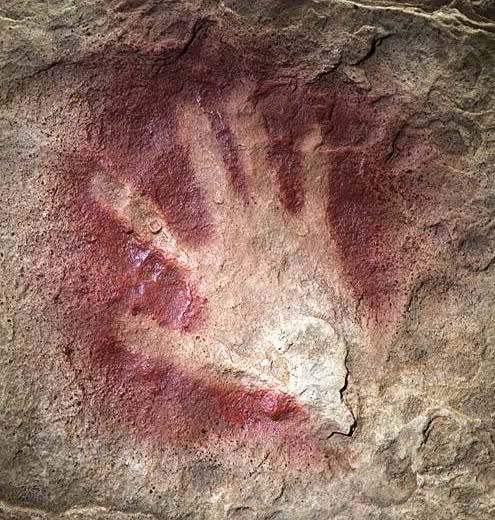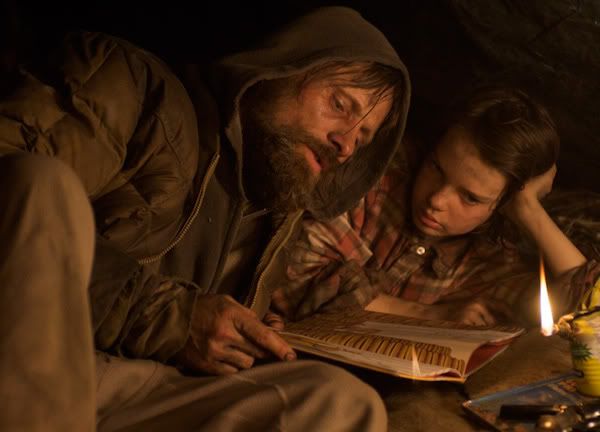IO.7
I0ve.
Friday, June 1, 2012
Signs Out of Time in Gimbutas’ Old Europe - The Goddess Remembered
" The Story of Archaeologist Marija Gimbutas
Portraying the life and works of one of the most prolific archaeologists of the twentieth century is a daunting undertaking. Compressing it into a one-hour documentary seems well-nigh impossible. That they succeed is a tribute to the understanding and film-making skills of Donna Read and Starhawk. A decade after their collaboration on the "Goddess and Spirituality" trilogy, the two team up to present this film-biography of one of the true prophets of our hidden past. A long-running prejudice of historical studies holds that civilization and written language were born together in the ancient Middle East amid an orgy of empire-building. Some of the oldest extant writings record the exploits of conquering kings. Gimbutas challenged this view by showing three things: First, that Neolithic urban settlements greatly pre-dated the "first cities" of the patriarchal tradition; Second, that at least some of these settlements had no defensive walls, no military burials, and no artwork recording warfare; Third, that the decorative designs of the artwork of these cultures may actually be a sophisicated system of symbols through which ideas and values could be recorded and transmitted.
Biography and Teachings
Signs Out of Times surveys Gimbutas's life and early academic career, in which she combined an interest in folklore with a deep knowledge of European languages. This combination helped open insights that remained closed to scholars whose cultural focus was classically formed, and whose standard of "language" was Latin or Greek. Against the backdrop of her life, the film turns to Gimbutas's theories about language and symbolism in Old Europe. Her conjectures sometimes seem far-fetched, as when she states that two spirals are in fact snakes coiling into two divine eyes (see graphic on page 63). But once we see some of the dozens or hundreds of similar pieces that Gimbutas studied - some naturalistic, others more abstract - the common symbolism becomes clear. From this discovery to the view that the symbols form a variegated system of interlocking meanings capable of carrying complex ideas and traditions is still quite a leap, and many scolars have rejected Gimbutas's theories. Even some of her admirers consider her views "outdated" and of "suggestive power" only. But during the last few years of his life, the great archaeologist and visionary historian Joseph Campbell spoke frequently of Marija Gimbutas, regretting that her research on the Neolithic cultures of Europe was not available during the 1960s when he was writing The Masks of God. Otherwise, he would have "revised everything." Campbell compared the importance of Marija's work to Champollion's decipherment of Egyptian hieroglyphics. He was not alone in this appreciation. According to anthropologist Ashley Montagu, "Marija Gimbutas has given us a veritable Rosetta Stone of the greatest heuristic value for future work in the hermeneutics of archaeology and anthropology."
Read more on http://www.reclaimingquarterly.org/web/gimbutas/gimbutas1.html
Full Documentary on youtube
Part 2 : http://youtu.be/OmjghytJDtQ
Part 3: http://youtu.be/GCZHgRcrFIc
Part 4: http://youtu.be/kqpSYTz-68c
Part 5: http://youtu.be/h7oNZZKrsDI
Part 6: http://youtu.be/nMxgOZPOHr4
Part 7: http://youtu.be/GKrVby1XNwg
(DVD)Signs Out of Time: The Story of Archaeologist Marija Gimbutas (2003)
Gimbutas’ Old Europe by By Deborah Barlow / Slow Muse
Source: http://slowmuse.wordpress.com/tag/marija-gimbutas/
"John Noble Wilford has written a fascinating article in the Science section of the New York Times (its location in the paper is telling) about an exhibit currently on view at NYU’s Institute for the Study of the Ancient World. Entitled “The Lost World of Old Europe: the Danube Valley, 5000-3500 B.C.,” the show includes more than 250 artifacts from museums in Bulgaria, Moldova and Romania. These treasures are being shown for the first time in the United States and will be on view through April 25. This is the culture that was of particular interest to the legendary archaeologist, mythologist and anthropologist Marija Gimbutas. Two of her books have been on my shelves since they were first published—The Language of the Goddess (published in 1989) and The Civilization of the Goddess (from 1991). Introduced to her work by Stephanie Hobart and Deborah Rose, I was stunned by the exquisite images of artifacts that she included in her publications, the likes of which I had never seen before. Why was this culture so relatively unexplored, particularly when compared to our knowledge of Sumerian, Egyptian and Prehistoric Greek cultures? Part of Gimbutas’ explanation for this was encapsulated in her strong statements about who these people were. She promulgated a view that the culture of Old Europe was matristric (woman-centered), a term she invented, and that its stories were lost when androcratic (male-centered) cultures invaded the region. Her theories were controversial when she first made her case, and the controversy continues even now, 15 years after her death. That ongoing debate is referenced in Wilford’s review of the show as well:
An arresting set of 21 small female figurines, seated in a circle, was found at a pre-Cucuteni village site in northeastern Romania. “It is not difficult to imagine,” said Douglass W. Bailey of San Francisco State University, the Old Europe people “arranging sets of seated figurines into one or several groups of miniature activities, perhaps with the smaller figurines at the feet or even on the laps of the larger, seated ones.” Others imagined the figurines as the “Council of Goddesses.”
Or else the “Thinker,” for instance, is the image of you, me, the archaeologists and historians confronted and perplexed by a “lost” culture in southeastern Europe that had quite a go with life back before a single word was written or a wheel turned."
Tuesday, November 8, 2011
The Missing Link : What if "The Road" continues with "Cave of Forgotten Dreams."
Three weeks ago I saw The Road, a movie that pushed me to the edge of my emotional state of being. That's because prior to watch this movie I've had so many conversations with my friends about how we should react in case of disaster, when your ultimate goal in life is to survive...years, months, days, seconds .
wikiPLOT
The Road shares the premise of the novel on which it is based: a father (Mortensen) and his young son (Smit-McPhee) struggle to survive a number of years after an unspecified, devastating cataclysm has destroyed civilization, killed all plant and animal life, and obscured the sun; only remnants of mankind remain alive, reduced to scavenging or cannibalism. Man and boy are traveling southward, in the hope that it will be warmer. Along the way, they search for shelter, food, and fuel, and avoid bands of cannibals while trying to maintain their own sense of humanity. The man carries a revolver, but has only two bullets which he wants to keep in case they need to commit suicide. Flashback and dream sequences spaced throughout the narrative show how the man's wife, who has a much more expanded role in the film than in the book, committed suicide after delivering the child and losing the will to go on in a seemingly doomed world.
Events occur along the way that add additional stresses to the man and his son. After shooting a member of a cannibal gang, the man is left with only one round in his gun. Later, the pair enter a large house, and discover it to be inhabited by cannibals who are keeping live victims in the basement and farming their limbs; believing they will be caught, the man prepares to shoot his son, to spare him the torments, but the cannibals are distracted and they escape. Further down the road they find a house with an underground shelter full of canned food, which they feast on, but the man is too nervous to stay in one spot for long. They later encounter an old, dying man (Duvall), and the son encourages his initially reluctant father to converse with the man and feed him. Arriving at the coast, they are robbed; they catch the thief and the man forces him to strip, leaving him naked by the road. As they pass through a ruined town, the man is shot with an arrow and he kills his attacker.
The father suffers from persistent coughing during the film eventually coughing up blood. After they reach the coast his condition deteriorates and he realizes he is likely to die soon. On his death bed he again emphasizes to his son the values of self-preservation and humanity. After the father dies, the son is approached by another family—a father (Pearce), mother, two children and a dog—who, it is revealed, have been following the man and his son for some time out of concern for the boy. The Boy agrees to join them.
And ?
How this film should continue ? How the modern mankind would survive ?
Today ROGER EBERT has posted a new blog entry about Werner Herzog's latest film "Cave of Forgotten Dreams " and suddenly I had a revelation ...
"About 32,000 years ago, in a limestone cave above the Ardèche River in Southern France, humans created the oldest cave paintings known to exist. They spring from the walls with boldness and confidence, as if the artists were already sure what they wanted to paint and how to paint it. Perhaps 25,000 years ago, a child visited the cave and left a footprint, the oldest human footprint that can be accurately dated. "
What if the beginning of the world as we know it was in fact just another epic tale of survival, love and sacrifice ? What if The Boy was The Child of The Cave ?
This vison of the last scene from The Road and Ebert's first words about " Cave of Forgotten Dreams " is now for me a missing link of my primordial cinematographic memory.
" In times of utter devastation, memories are what we cling to." Roger Ebert , The Road
29.12.2010 - BBC update
Cave painters were realists, DNA study finds
It's not just a matter of aesthetics: Paintings based on real life can give first-hand glimpses into the environment of tens of thousands of years ago. But scientists have wondered how much imagination went into animal drawings etched in caves around Europe.
The latest analysis published online Monday in the Proceedings of the National Academy of Sciences focused on horses since they appeared most frequently on rock walls. The famed Lascaux Cave in the Dordogne region of southwest France and the Chauvet Cave in southeast France feature numerous scenes of brown and black horses. Other caves like the Pech Merle in southern France are adorned with paintings of white horses with black spots.
Past studies of ancient DNA have only turned up evidence of brown and black horses during that time. That led scientists to question whether the spotted horses were real or fantasy.
To get at the genetics of equine coat color, an international team led by the Leibniz Institute for Zoo and Wildlife Research in Germany analyzed DNA from fossilized bones and teeth from 31 prehistoric horses. The samples were recovered from more than a dozen archaeological sites in Siberia, Eastern Europe, Western Europe and the Iberian peninsula.
It turned out six of the horses had a genetic mutation that gives rise to a spotted coat, suggesting that ancient artists were drawing what they were seeing. Brown was the most common coat color, found in 18 horses.
Researchers who were not part of the study praised the use of genetics, saying it supports their observations.
Paleoanthropologist John Shea of Stony Brook University in New York said he was not surprised that cave artists were in tune with their surroundings since they needed to know all they could about their prey to hunt them.
"These artists were better observers of their natural environment than many humans are today," Shea said in an email.
Just because cave art was rooted in reality doesn't mean Ice Age painters lacked creativity.
Archaeologist Paul Pettitt of the University of Sheffield in England said ancient artists were "immensely creative," using techniques such as charcoal shading that are still found in modern art.
This undated photo provided by the Pech Merle Prehistory Center shows a cave painting of pair of spotted horses, found in the Pech Merle Cave in Cabrerets, southern France. Scientists estimate the drawing, measuring about 4 meters wide by 1.5 meters high, is about 25,000 years old. An ancient DNA study found that Ice Age artists drew horses based on their observations rather than imagination.

Source: http://news.yahoo.com/cave-painters-were-realists-dna-study-finds-200120657.html
Wednesday, October 19, 2011
New Light on Human Prehistory in the Arabo-Persian Gulf Oasis.
A once fertile landmass now submerged beneath the Persian Gulf may have been home to some of the earliest human populations outside Africa, according to an article published in Current Anthropology.
Jeffrey Rose, an archaeologist and researcher with the University of Birmingham in the U.K., says that the area in and around this "Persian Gulf Oasis" may have been host to humans for over 100,000 years before it was swallowed up by the Indian Ocean around 8,000 years ago. Rose's hypothesis introduces a "new and substantial cast of characters" to the human history of the Near East, and suggests that humans may have established permanent settlements in the region thousands of years before current migration models suppose.
In recent years, archaeologists have turned up evidence of a wave of human settlements along the shores of the Gulf dating to about 7,500 years ago. "Where before there had been but a handful of scattered hunting camps, suddenly, over 60 new archaeological sites appear virtually overnight," Rose said. "These settlements boast well-built, permanent stone houses, long-distance trade networks, elaborately decorated pottery, domesticated animals, and even evidence for one of the oldest boats in the world."
But how could such highly developed settlements pop up so quickly, with no precursor populations to be found in the archaeological record? Rose believes that evidence of those preceding populations is missing because it's under the Gulf.
"Perhaps it is no coincidence that the founding of such remarkably well developed communities along the shoreline corresponds with the flooding of the Persian Gulf basin around 8,000 years ago," Rose said. "These new colonists may have come from the heart of the Gulf, displaced by rising water levels that plunged the once fertile landscape beneath the waters of the Indian Ocean."
Historical sea level data show that, prior to the flood, the Gulf basin would have been above water beginning about 75,000 years ago. And it would have been an ideal refuge from the harsh deserts surrounding it, with fresh water supplied by the Tigris, Euphrates, Karun, and Wadi Baton Rivers, as well as by underground springs. When conditions were at their driest in the surrounding hinterlands, the Gulf Oasis would have been at its largest in terms of exposed land area. At its peak, the exposed basin would have been about the size of Great Britain, Rose says.
Evidence is also emerging that modern humans could have been in the region even before the oasis was above water. Recently discovered archaeological sites in Yemen and Oman have yielded a stone tool style that is distinct from the East African tradition. That raises the possibility that humans were established on the southern part of the Arabian Peninsula beginning as far back as 100,000 years ago or more, Rose says. That is far earlier than the estimates generated by several recent migration models, which place the first successful migration into Arabia between 50,000 and 70,000 years ago.
The Gulf Oasis would have been available to these early migrants, and would have provided "a sanctuary throughout the Ice Ages when much of the region was rendered uninhabitable due to hyperaridity," Rose said. "The presence of human groups in the oasis fundamentally alters our understanding of human emergence and cultural evolution in the ancient Near East."
It also hints that vital pieces of the human evolutionary puzzle may be hidden in the depths of the Persian Gulf.
Source: Since Daily
Story Source:
The above story is reprinted (with editorial adaptations by ScienceDaily staff) from materials provided by University of Chicago Press Journals, via EurekAlert!, a service of AAAS.
Journal Reference:
Jeffrey I. Rose. New Light on Human Prehistory in the Arabo-Persian Gulf Oasis. Current Anthropology, 2010; http://birmingham.academia.edu/JeffreyRose/Papers/359690/New_Light_on_Human_Prehistory_in_the_Arabo-Persian_Gulf_Oasis

About Dr. Jeffery Rose
Dr. Jeffrey I. Rose is a Research Fellow at the Institute of Archaeology and Antiquity, University of Birmingham. His areas of interest include prehistoric archaeology of the Arabian Peninsula, modern human origins, stone tool technology, human genetics, rock art, geoarchaeology, underwater archaeology, and geomythology. He holds a B.A. in Classics, an M.A. in Archaeology from Boston University, and an M.A. and Ph.D. in Anthropology from Southern Methodist University.
Over the past 22 years, Jeff has conducted archaeological fieldwork in North America, Wales, Ukraine, Israel, Portugal, Yemen, the United Arab Emirates, and Oman. Since 2000, he has directed an ongoing archaeological survey and excavation project in southern Arabia to explore early human dispersals into Arabia. The project was recently featured in the 2009 BBC documentary series "Incredible Human Journey."
Jeff currently resides in Muscat, Oman where he runs the Dhofar Archaeological Project (DAP). DAP is a comprehensive investigation of prehistoric archaeology, palaeoenvironments, and human genetics in the Dhofar region of Oman (link to the project's website: http://dhofar.arabian-prehistory.org). You can also follow DAP on Twitter @dhofarproject for expedition updates during our annual winter field season.
Monday, October 17, 2011
The tree of life and the Jurrasic subway station from Bucharest
Jurassic underground in Bucharest
Politehnica subway station in Bucharest, Romania, is paved with marble plates full of fossils, which lived on Earth during Cretaceous ( 145.5 ± 4 to 65.5 ± 0.3 million years ago.) The Cretaceous was a period with a relatively warm climate and high eustatic sea level. The oceans and seas were populated with now extinct marine reptiles, ammonites and rudists; and the land by dinosaurs.
It seems that in a hurry to launch the subway station, the builders haven't paid much attention of what kind of marble they use. Since 1983, the marble extracted from Rosia Montana (Apuseni Mountains, Transylvania) is lying on the floor like a red carpet full of "crumbs" older than 80 million years. Epic.
More pictures and full article here. ( It is translated in English from Romanian with Google translate, that's why in the headline is written I <3 London instead of I <3 Bucharest )
The marble from the subway station
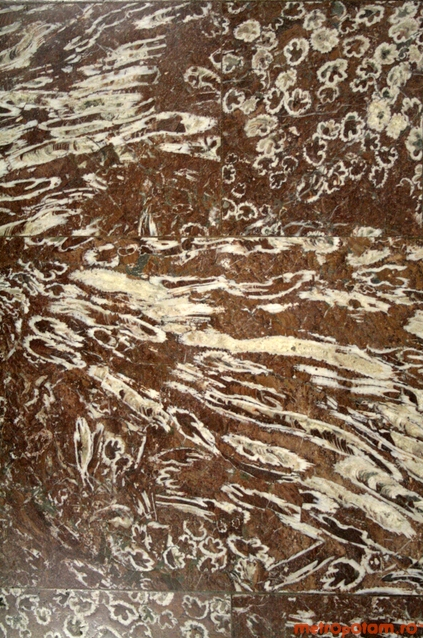
A scene from Tree of Life , the era of dinosaurs from where the marble comes.
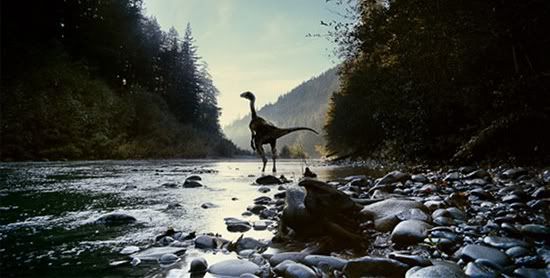
and the same scene from the screenplay written by Terrence Malick


Wednesday, September 7, 2011
Secrets of the Black Sea - Uncovering the Roots of Early Civilization
Documentary - 57 min
Today scientists are beginning to discover what may have caused the oceans to rise and are developing new insights about an ancient advanced culture that existed in this mysterious part of the world. This program presents amazing archeological evidence of ancient advanced technology and a long lost advanced civilization that flourished in the Dead Sea region before the end of the last Ice Age.
Includes the facts about this amazing mystery and features, on-site investigations, ancient artifacts, under water archeology, and a fascinating series of spellbinding interviews with researchers, scientists, archeologists and the best-known most credible Black Sea authorities in the world today.
"Related to the flood is a short recent book with a lengthy bibliography written by Ioan Sorin Apan of Brasov, Romania. A student of Romanian folk customs and legends, he collected contemporary peasant stories handed down over the ages that still contain accounts of a great flood. His insights - triggered by the publicity surrounding the oceaneographic research of William Ballard in the Black Sea - is a significant contribution to the endurance of folk tradition and the passing, through stories passed on from one generation to the next, of ancient memories. "I always wondered why people far inland from the sea could be telling stories that spoke of a great and fearful flood."
SEE: Taina Marii Negre: oceanografie si folclor, Ion Sorin Apan (undated)"
http://www.roconsulboston.com/Pages/InfoPages/Commentary/Cradle.html
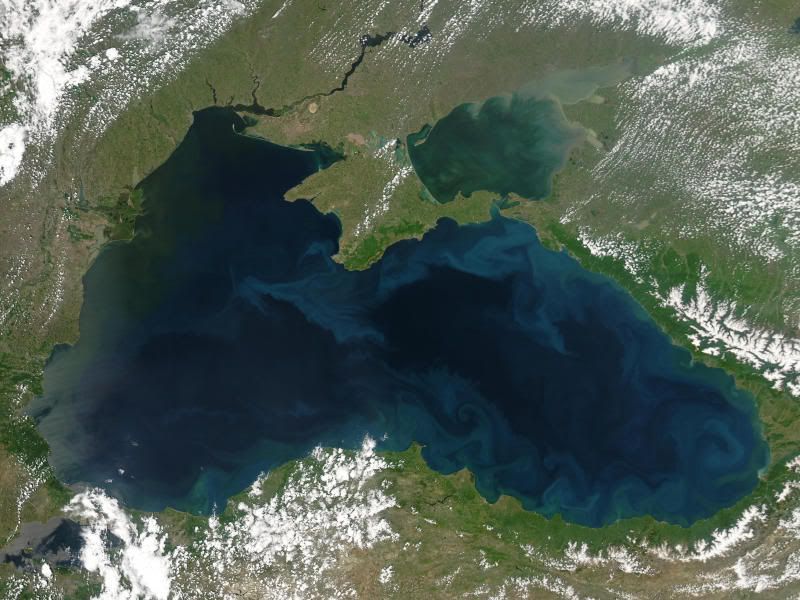
NASA - Black Sea
Tuesday, December 21, 2010
The origins of tablets, collective intelligence and the metaphor of the end of the world.
An advertsing for Motorola presents the evolution of tablet. It starts with the Egyptian hieroglyphic tablet 3200 BC explaining that weight it makes it difficult for portability.
And here is the moment when the collective intelligence discovers in my memory, with a typical tangential move , the origins of tablet. Not the evolution , but the origins.
5300 BC Transylvania
TARTARIA TABLETS
The Tărtăria tablets are three tablets, known since the late 19th century excavation at the Neolithic site of Turdaş in Transylvania, Romania, by Zsófia Torma, which date to around 5300 BC.They bear incised symbols, the Vinča signs, that have been the subject of considerable controversy among archaeologists, some of whom claim that the symbols represent the earliest known form of writing in the world.
Two of the tablets are rectangular and the third is round. They are all small, the round one being only 6 cm (2½ in) across, and two—one round and one rectangular—have holes drilled through them.
As RevezNexus, a very good twitter friend , mentioned last night, Dracula was a happy man :)
Result: very portable

Nothing is new on Earth, it seems that we write the future with the DNA of the past. We don't have to exclude the fact that maybe thousands of years ago, on Earth, a very advanced civilization has disappeared during a catastrophic event. The survivors have succeded to create a new world. Maybe this is a scifi scenario, maybe not. I wrote months ago on my IO.1 blog The Missing Link : What if "The Road" continues with "Cave of Forgotten Dreams.", a post that is questioning the same dilema.
Now we we have the chance to create a new world without destroying the old one. We have the chance to learn from our mistakes and to open a new era for the whole humanity.
So I would advice all the tablets brands to create an entire documentary about the evolution and origins of tablet. It can be a wonderful recognition for the human innovation and also an inspiration for the new generation of collective intelligence .
The end of the world is close, prepare to be amazed of the new one...
Monday, November 1, 2010
Endless Column
Another most significant opinion aboout on the "Endless Column" at the comparasion level appread in London, England, several year after sculptor's demise:
"The Endless Column is the only sculpture of the modern era that bears comparasion with the great monuments of Egypt, Greece and the Renaissance"
William Tucker, "The Hand That Change The Forms" in The Daily Telegraph, July 20, 1973
Such an accurate comparasion explains why Peggy Guggenheim offered several million dollars for the original Column (5 million, which at that time, was the equivalent amount of the annual budget of a big Romanian city as Bucharest ), but the Romanian Governement refused the offer.

Saturday, October 30, 2010
A vison of the future - Where The Mind is Without Fear
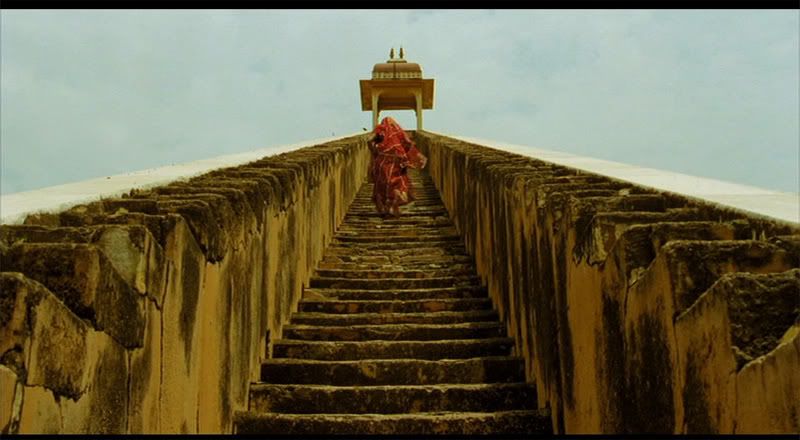
Picture from The Fall, a film by Tarsem Singh
Where the mind is without fear and the head is held high;
Where knowledge is free;
Where the world has not been broken up into fragments
Where words come out from the depth of truth;
Where tireless striving stretches its arms towards perfection;
Where the clear stream of reason has not lost its way into the
dreary desert sand of dead habit;
Where the mind is led forward by thee into ever-widening
Into that heaven of freedom,
Rabindranath Tagore
This poem is from Gitanjali, lit. Offering of Songs, published in English in
1910.







